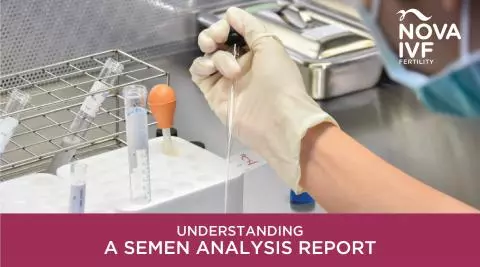Why Semen Analysis Is Important for Male Infertility Treatment

If you are having trouble getting pregnant, the first step is to evaluate the fertility of both partners. Studies have found that it could be either partner – the man or the woman – who could be infertile. In this article we will be focusing on male infertility treatment. Sperm parameters, while far from perfect, can serve as a guide to what type of treatment a couple may need.
The male infertility test includes a detailed semen analysis that tracks a number of parameters like sperm count, sperm concentration, and motility. Compared to many other tests used in the assessment of the infertile couple, semen analysis report has been standardised throughout the world. The standardisation of measurement of sperm concentration and semen volume allows for more accurate calculation of sperm output.
Volume
Volume measures the quantity of the man’s ejaculate in millilitres. WHO regards 1.5 ml as the lower reference limit and anything between 1.5 – 5 ml is considered normal. Low volumes could indicate a partial or complete blockage or dysfunction in the seminal vesicles or prostate.
Sperm Density
Sperm density or sperm concentration measures the concentration of sperm in a man’s ejaculate – in other words, how many million sperm per millilitre.
WHO considers a sperm count of 15 million/ml or above to be adequate. Lower numbers may indicate that the testicles are not producing sperm the way they should, indicating Oligozoospermia, a sign of male infertility.
Total Sperm Count
Total sperm count, or total sperm number, is the total number of spermatozoa in the entire ejaculate. By WHO, the lower reference limit (5thpercentile) is 39 million per ejaculate.
Motility
Sperm motility measures the number of moving sperms as well classifies them according to their movement. Motility should be in the range of 40-50%. A lower number may indicate that there is toxin exposure such as smoking, alcohol, chemicals from a job or hobby and caffeine. Low motility can also indicate hormonal problems or a varicocele (varicose veins in the scrotum).
Morphology
Morphology refers to the shape of the sperm. The percentage of normally shaped sperm is evaluated to determine male fertility. A low number of normally shaped sperm can decrease the chances of pregnancy.
pH
pH level measures the acidity in the semen. WHO criteria specify normal as 7.2-7.8.A low pH level means the semen is acidic, while a high pH level indicates it is alkaline. An abnormal pH can affect the health of the sperm and how well it moves.
Fructose Level
Normal semen contains fructose to provide energy for the sperms. Absence of fructose may indicate a problem with the seminal vesicles.
Liquefaction
Normal semen comes out thick during ejaculation. Liquefaction time measures how long it takes before it becomes liquid. It should take about 20-30minutes. If yours takes longer, or doesn’t become liquid at all, it could mean there’s a problem.
With male infertility factor contributing to 40-45% of infertility-related cases, it’s absolutely imperative for a couple to ensure the male as much as the female gets tested for his fertility potential. Understand that the man’s fertility levels can help erase a number of probabilities considered as the cause of infertility in the couple. And, the most important test for male infertility is the Routine Semen Analysis.
 Infertility Counselling
Infertility Counselling Female Infertility Treatment
Female Infertility Treatment Andrology Treatment
Andrology Treatment Fertility Enhancing Surgeries - Female
Fertility Enhancing Surgeries - Female Fertility Enhancing Surgeries - Male
Fertility Enhancing Surgeries - Male Endoscopy Treatment
Endoscopy Treatment IUI Treatment
IUI Treatment IVF Treatment
IVF Treatment ICSI Treatment
ICSI Treatment Advanced IVF Solutions
Advanced IVF Solutions Embryology
Embryology Vitrification Egg, Embryo, Sperm Freezing
Vitrification Egg, Embryo, Sperm Freezing Preimplantation Genetic Testing (PGT)
Preimplantation Genetic Testing (PGT) Donation Program Embryo / Egg / Sperm
Donation Program Embryo / Egg / Sperm Self-cycleTM IVF
Self-cycleTM IVF

 Self-cycleTM IVF
Self-cycleTM IVF









